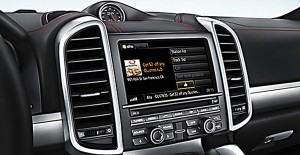
On the go and hungry? No problem. You've got a coupon for a sandwich popping up on your videoscreen.
You’re on your way to work and notice your stomach growling. No problem. An ad for the local McDonald’s has popped up on your navigation screen. Later that day, as you head home, a different ad pops up, this one with a coupon for your favorite take-out pizza parlor.
At least, that’s the concept mobile marketing firm Placecast and in-car streaming audio service Aha Radio are demonstrating – and which could become the next big thing for advertisers that want to reach consumers when they are most open, or if you prefer most vulnerable, to their message.
The partners are running a nationwide pilot this month with sandwich shop Quiznos as their first advertiser.
“We are excited about the opportunity to deliver relevant, value-added experiences for consumers in the car,” said Alistair Goodman, CEO of Placecast. “We have seen strong results for this kind of marketing in the mobile arena, and we expect to see positive consumer reception to this extension of localized offers into cars.”
It’s called location-based, in-car advertising and it takes the marketing capabilities of the Internet to the next level. First came the banners and billboards which randomly popped up on your computer screen. Advances in tracking technology has allowed a service like Google Adsense to better target what ads you might see and when. But mobile advertising promises to not only deliver ads that should appeal to a particular consumer but also to ensure they come up at the best possible time.
(Ford produces 10 millionth vehicle with Sync system. Click Here for the story.)
Using so-called geo-fencing technology, a restaurant could, for example, deliver an ad and coupon in the evening when you’re within a 10-mile range.
Consumers are today bombarded with advertising from the moment they wake up until the moment they turn the lights out at night. Motorists already hear a stream of commercials on their car radios and watch as the billboards fly by. Until now, however, they’ve largely been spared the ad intrusion on their in-car infotainment systems. But as this technology rapidly proliferates – Ford, for example, just built the 10 millionth car equipped with its Sync system – advertisers have been positively salivating at the opportunities this presents.
(Automakers plagued by problems with infotainment technology, warns Consumer Reports. Click Here for the story.)
The Aha Radio app, developed by Harman, provides a good opportunity to test the new location-based technology because it is now being used by 2 million Americans and can pair up with more than 50 different car models sold in the U.S. by makers including Toyota, Ford and Honda. Automakers have been racing to pair even more of their vehicles with more popular apps, such as Stitcher and Pandora, which could mean even more in-car ad experiments in the months to come.
The critical difference between a location-based approach and conventional advertising is the ability to precisely target consumers as they move about – and the technology can be adapted for both a car and for a smartsphone handset in the pocket of someone walking through a mall or downtown shopping district.
Consumers could actually help hone the service by storing coupons and selecting favorite stores or restaurants that would automatically pop up at the appropriate time and place, explain location-based marketing developers.
“Not only are the promotional offers contextual, but geo-aware and interactive,” said Tobin Trevarthen, Vice President of Advertising Revenue for Aha. “This is a completely new concept and capability that enables advertisers to reach existing customers as well as new consumers when they are in a mindset to make a purchase – on-the-go and engaged in their daily lives. We think this is a compelling marketing strategy for advertisers.”
For the moment, Aha and Placecast are asking consumers to opt in – for free – to the new service. When they’re driving, they’ll receive geo-triggered audio offers. A motorist can then tap a button if they choose to receive a coupon by e-mail. Ads can also pop up on the video screen — though that approach will likely have to be vetted to ensure it doesn’t worsen the problem with distracted driving.
(Can technology aid the fight against distracted driving? Click Here to find out.)

I hope that the auto makers and advertisers get sued to the high heavens when people crash their cars based on these constant additions to driver distraction.